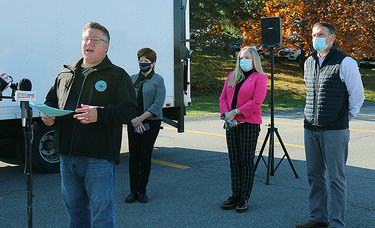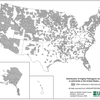County suffers another death and 69 new COVID-19 cases
The Enterprise — Michael Koff
“People aren’t being honest with us most of the time,” said Albany County Executive Daniel McCoy. “They’re not being truthful where they’re at, if they’re at a party.” He spoke of the importance of contact tracing to stem the spread of coronavirus at a press briefing in Colonie on Saturday morning. Behind him, from left, are Albany Mayor Kathy Sheehan, Albany County Health Commissioner Elizabeth Whalen, and Albany County Deputy Executive Daniel Lynch.
ALBANY COUNTY — “Vigilant” was the word of the day on Saturday.
It was used by the county’s executive, Daniel McCoy, at a press briefing in Colonie as he announced the death of another Albany County resident from COVID-19.
A woman in her nineties with underlying health conditions died of the virus on Thursday. This brings the county’s COVID-19 death toll to 143.
McCoy also announced 69 new COVID-19 cases. “Not since April 29 have we had close to that number,” he said, calling it “very alarming.”
“Vigilant” was used, too, by the county’s health commissioner, Elizabeth Whalen, as she warned, “We are starting to see many cases; we are starting to see more severe cases.”
And it was used by the governor, Andrew Cuomo, as he announced the latest state numbers.
“Cases are increasing across the country and the globe — and there are several warning flags in New York,” said Cuomo in a press release. “The challenge for our state has been to manage the increase and try to ensure the spikes in other states don’t impact us too much ...
“As we head into winter months, it’s going to take the work of all New Yorkers to ensure we don’t go back to where we were this spring — I understand COVID fatigue is real, but it’s on all of us to stay vigilant and wear our masks, wash our hands, remain socially distant and stay New York Tough.”
Contact tracing
McCoy, Whalen, and Albany Mayor Kathy Sheehan at their press confeence all stressed the importance of contact tracing.
Whalen said she had received an email, calling the two-week quarantine period “Draconian.”
She explained why it is “an essential public-health strategy.”
When someone tests positive for COVID-19, the health department asks who he or she has been in close contact with. Those people are then asked to isolate themselves for 14 days.
Whalen explained that the incubation period for COVID-19 is 14 days.
“Individuals start to spread the virus two days before they become symptomatic so you are spreading the virus even if you are well,” she said.
She urged people to follow the quarantine “as if someone you love’s life depends upon it because it might,” Whalen said.
The new travel policy announced by the state last month — visitors flying into airports from other states must present negative COVID-19 test results, taken within three days. County health departments are responsible for tracking and tracing any positive cases that develop.
Asked about monitoring train and bus stations, McCoy said, of county health-department workers, “Our people are tired.” The county’s workers have tracked and traced 3,858 cases over the last seven months. McCoy said probably more people will be trained.
“The state is pushing more and more of this down on us … We don’t have the men and women power,” he said.
Whalen said of the infection rate, “We are looking at numbers we haven’t seen since the spring and we are seeing more spread … more close contacts.
McCoy noted that, of the 69 new cases, 32 had no clear source of infection identified.
“People aren’t being honest with us most of the time,” he said. “They’re not being truthful where they’re at, if they’re at a party.”
He reiterated as he has in the past, “We’re not going to have you arrested. We’re not throwing you in jail. We just need you to be honest so we can do our job and stop the spread.”
Similarly, Sheehan urged, “Cooperate with the contact tracers. It could save a life.”
McCoy also spoke of the plight of small businesses, many of which, he said, have gone through their savings. He urged, “Help us stay open … the mom and pop restaurants are barely surviving.”
Last month, the state adopted an approach to focus on micro-clusters of the disease. In those areas, over-sampling is done and restrictions are put in place. In red zones, schools and nonessential businesses are closed and gatherings are prohibited. Red zones are surrounded by orange zones and then outlying yellow zones, each with lesser restrictions.
Thanksgiving
Sheehan addressed the upcoming Thanksgiving holiday. She urged college students to be tested before they head home for Thanksgiving break so as not to unwittingly spread the disease.
Sheehan also said of Thanksgiving, “I know it’s hard … and I know we want to be with our families … and I also know we don’t want to get one another sick.”
She said she knew many people who had been “very, very sick” with the disease and she knew families who this year may be “gathering virtually without a loved one” who died of COVID-19.
McCoy said, “It’s just one Thanksgiving away from your family.” He said that is something people in military service regularly have to endure.
“It’s not gonna kill you not to see Mom and Dad … You’ve got your phone, you’ve got FaceTime, you’ve got Zoom,” said McCoy. “Do it differently one year.”
Newest numbers
Statewide, the positive testing rate, based on Friday’s results, was 2.19 percent. This includes the micro-clusters, which alone had a positivity rate of 4.22 percent.
The Capital Region, of which Albany County is a part, had a rate of 1.7 percent. All 10 regions in the state had positivity rates over the original target of 1 percent. The highest was Western New York at 4.3 percent.
As of Saturday morning, Albany County has 3,858 confirmed cases of COVID-19.
Of the 69 new cases, 25 had close contact with someone infected with the disease, six reported traveling out of state, 32 did not have a clear source of infection identified at this time, and six are health-care workers or residents of a congregate setting.
Currently, 1,311 county residents are under quarantine, up from 1,215. The five-day average for new daily positives jumped to 43.2 from 34.4. There are now 253 active cases in the county, up from 224 yesterday.
So far, 17,527 county residents have completed quarantine. Of those, 3,605 had tested positive and recovered.
Seven more county residents were hospitalized overnight, while the number of county residents currently hospitalized due to the virus increased to 31 from 29. Three of those patients are in intensive-care units. The hospitalization rate has gone up to 0.80 percent from 0.73 percent.
“As our hospital numbers start to uptick, we become concerned with surge capacity for our hospitals,” said Whalen at Saturday morning’s press conference. “We are in a very critical period right now, which will determine what happens in the coming days, weeks, and months.”


